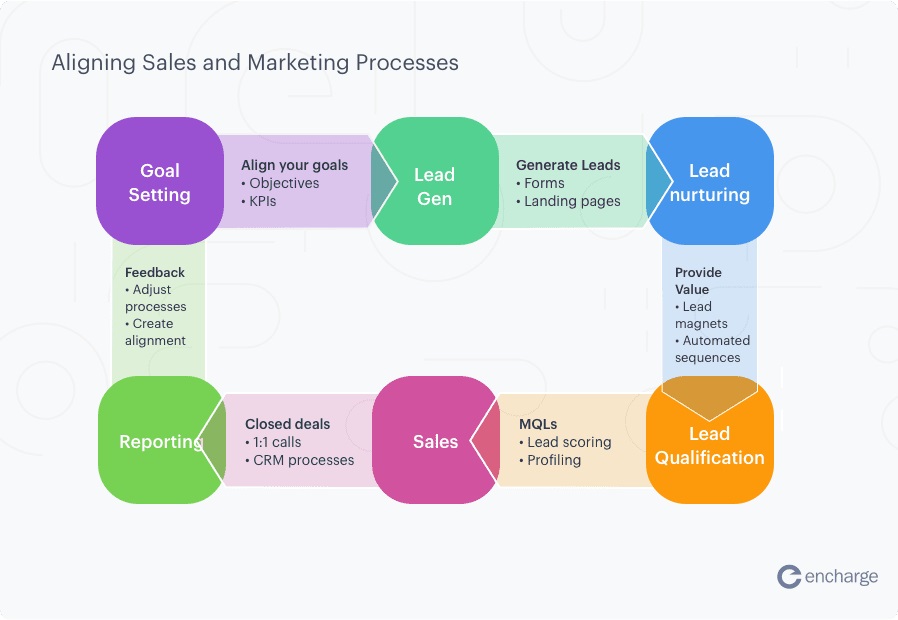In today’s fast-changing market, where competition is tough and customers want more, it’s really important to get your sales team to work efficiently.
Making the most out of your sales team’s work is very important to grow your business and stay ahead of everyone else. It’s not just about selling products; it’s about creating smooth and valuable experiences that customers will like.
Companies that use sales productivity in the best way are not only keeping up with the times but are also leading the way, ready to handle any changes in the market.
Customer relationship management (CRM) plays a crucial role in enhancing sales productivity by storing customer data, managing sales activities, and tracking performance metrics.
Let’s move towards understanding how you can revamp your sales strategy to boost the productivity of your sales team.
What Is Sales Productivity?

Sales productivity boils down to doing more with less. It’s about effectively utilizing resources – time, people, tools, and processes – to drive revenue generation. To gain insights into the effectiveness and efficiency of sales teams, it is crucial to measure sales productivity using various metrics and tools. It encompasses both efficiency (doing things right) and effectiveness (doing the right things).
When your sales team is productive, they close more deals, hit quotas faster, and ultimately contribute to a healthier bottom line.
Benefits of Increased Sales Productivity
Increased sales productivity has numerous benefits for businesses, including:
- Improved Employee Morale: When sales teams are productive, they are more likely to feel a sense of accomplishment and satisfaction. This boost in morale can lead to reduced turnover rates, as employees feel valued and motivated to continue performing at their best.
- Increased Revenue: By closing more deals and generating more revenue, businesses can experience significant growth and expansion. A productive sales team directly contributes to the bottom line, driving financial success and enabling further investment in resources and development.
- Better Customer Satisfaction: Productive sales teams can provide better customer service, leading to increased customer satisfaction and loyalty. When sales reps are efficient and effective, they can address customer needs promptly and accurately, fostering long-term relationships.
- Improved Sales Performance: By streamlining sales processes and eliminating inefficiencies, businesses can improve their overall sales performance and competitiveness. A focus on productivity ensures that every step of the sales process is optimized, leading to better outcomes and a stronger market position.
Evaluating Sales Performance
Evaluating sales performance is crucial to measuring sales productivity and identifying areas for improvement. Here are some key steps to follow:
Determine KPIs

Determining the right KPIs (Key Performance Indicators) is essential to evaluating sales performance. Some common KPIs for sales teams include:
- Sales Revenue: The total income generated from sales activities. This is a primary indicator of a sales team’s success.
- Customer Acquisition Cost (CAC): The cost associated with acquiring a new customer. Lowering CAC can significantly improve profitability.
- Customer Lifetime Value (CLV): The total revenue a business can expect from a single customer account. Increasing CLV indicates strong customer relationships and repeat business.
- Sales Conversion Rate: The percentage of leads that convert into actual sales. A higher conversion rate reflects effective sales strategies and processes.
- Sales Cycle Length: The average time it takes to close a deal. Shortening the sales cycle can lead to faster revenue generation and improved efficiency.
Establish Goals
Establishing clear and achievable goals is essential to evaluating sales performance. Goals should be specific, measurable, achievable, relevant, and time-bound (SMART). Examples of sales goals include:
- Increasing Sales Revenue by 10% Within the Next Quarter: Setting a specific revenue target helps focus efforts and measure success.
- Reducing Customer Acquisition Cost by 20% Within the Next Year: Lowering CAC can improve overall profitability and allow for more efficient use of resources.
- Improving Sales Conversion Rate by 15% Within the Next Six Months: Enhancing conversion rates can lead to more closed deals and better use of leads.
6 Actionable Strategies to Increase Sales Productivity
1. Align Sales & Marketing Goals
Make sure your sales and marketing teams are on the same page. When both teams share common goals, it’s easier to target the right customers and close deals. This alignment makes the whole process smoother and more effective.

Define clear, shared objectives for both departments. Craft detailed buyer personas, ensuring both teams target the right prospects with the right messaging. Share these profiles regularly to keep everyone on the same page.
Foster open communication channels. Create joint meetings, share performance data, and encourage cross-team collaboration. Remember, information silos are productivity killers.
2. Streamline the Sales Process
Make your sales process simple by optimizing sales processes and resource allocation to enhance sales efficiency. This will help your sales team focus on what is important – building relationships and closing deals.
Start by drawing a visual map of your current sales process to identify bottlenecks, redundant steps, and unnecessary complexity. Remove these problems to make the sales process easier.
Standardize and streamline processes for key activities such as outreach, presentations, and follow-up. This consistency will help eliminate confusion and help your team operate smoothly.
Also, don’t forget to talk to your salespeople and customers often to gain key insights on what’s happening and how things can be improved further.
3. Leverage Technology to Automate Tasks
Use technology to automate repetitive tasks. It saves time and reduces errors, letting your team concentrate on important parts of their job instead of getting bogged down with manual work.
To leverage the right technology you first need to assess your workflow to understand where more attention is required. Identify repetitive and time-consuming tasks that can be automated, such as data entry, email follow-ups, or report generation.

Invest in user-friendly automation tools that align with your team’s needs such as prospecting tools, CRMs, or email outreach automation, basically the activities that your sales team does regularly and on a larger scale.
Offer training to ensure everyone is comfortable using the new tools. Regularly evaluate the effectiveness of the automation process, seeking feedback from your team for continuous improvement. This ensures that technology serves as a time-saving ally rather than a source of frustration.
4. Use Incentives to Motivate Your Team
Recognition and rewards are the two best ways to keep your employees motivated to keep up their good work. So, whether it’s bonuses, commissions, or recognition, giving your sales team a reason to excel will foster a positive and more productive sales environment.
Since everybody is different, you can start by conducting surveys or casual discussions to discover what motivates them – whether it’s monetary rewards, recognition, or a combination of both.
Establish clear and achievable performance metrics tied to the incentives. Regularly communicate the progress towards these goals and celebrate achievements publicly. Ensure transparency in the incentive structure, so everyone understands the criteria for rewards.
Periodically review and adjust incentives to keep them fresh and aligned with evolving team dynamics, maintaining a positive and energized sales environment.
5. Provide Ongoing Sales Training & Coaching
Equipping sales professionals with the necessary skills and knowledge to succeed in their roles is crucial. Regular training and coaching sessions help your sales team stay up-to-date with the latest selling techniques and industry knowledge. This equips them with the skills to face challenges better and lead things towards a positive outcome.

Start by identifying specific skill gaps within your team through regular assessments or feedback sessions. Provide accessible and relevant training materials, incorporating both online resources and in-person coaching sessions.
Encourage mentorship within the team to foster knowledge sharing. Schedule regular training sessions, ensuring they are concise, interactive, and tailored to address current market trends.
Facilitate a feedback loop, allowing team members to share insights from training sessions and suggest areas for further development.
Track & Measure Performance: Measuring Sales Productivity

Keep an eye on how your sales rep team is doing. Regularly checking performance helps you measure sales rep activities to identify opportunities for improving workflows and increasing effectiveness, leading to better sales productivity.
Begin with defining clear and quantifiable key performance indicators (KPIs). Implement a centralized system or software that consolidates relevant data for easy analysis.
Regularly review performance metrics with your team, emphasizing constructive feedback and goal-setting. Use a balanced approach, recognizing both individual and team achievements.
Encourage a data-driven mindset, empowering team members to take ownership of their performance. Regularly revisit and refine KPIs based on evolving business objectives and market conditions, ensuring a continuous improvement cycle for enhanced sales productivity.
Tools to Improve Sales Productivity
1. CRM Software
Having a centralized hub for all your sales data is crucial for organization, efficiency, and visibility. Customer relationship management (CRM) software helps in managing customer data and sales activities. A good sales CRM tracks leads, manages contacts, stores deals, and streamlines communication, giving your sales team a complete picture of the sales pipeline and customer lifecycle.

- HubSpot CRM: A free and user-friendly option perfect for startups and small businesses to manage leads, contacts, and communication, all within a clean and intuitive interface.
- Salesforce: A comprehensive CRM platform catering to enterprises of all sizes packed with advanced capabilities like sales automation, reporting, and customization.
- Zoho CRM: A budget-friendly and flexible solution ideal for businesses of all sizes with a wide range of features at an affordable price, making it a great value-for-money tool.
2. Project Management Software
Project management platform helps you visualize each stage, organize tasks within deals, and track progress in real-time. This ensures everyone is on the same page, tasks are completed on time, and potential roadblocks are identified early on, preventing deals from stalling. Investing in a project management software like Asana or Trello will help you keep your sales team productive.
- Asana: Empowers teams to manage tasks, and projects, and collaborate seamlessly by providing clear overviews of sales pipelines and deal progress.
- Monday.com: A visual and customizable platform for managing projects and workflows, allowing for easy tracking of sales activities and deadlines.
- Trello: A simple and flexible tool for organizing projects using boards and cards, providing a clear visual representation of your sales pipeline & team workload.
3. Sales Gamification Tools
Sales Gamification tools inject a competitive and fun element into the sales process, significantly enhancing sales team productivity. It fosters a dynamic and engaging environment, boosting team morale and driving healthy competition, ultimately improving overall sales performance.
- Spinify: Spinify is specifically designed for sales teams. It uses AI and gamification elements such as points, badges, and leaderboards to drive engagement and friendly competition, keeping your reps motivated and focused on exceeding their targets. By incorporating real-time feedback and visual progress tracking, Spinify not only boosts motivation but also fosters a culture of achievement and recognition within the team.
- Sales reps can see their performance metrics in comparison to their peers, creating a dynamic and competitive environment that encourages continuous improvement. This approach not only enhances individual productivity but also strengthens team cohesion, as members are inspired to collaborate and support each other in reaching collective sales goals. Furthermore, Spinify’s customizable features allow sales leaders to tailor the gamification experience to align with specific business objectives, ensuring that the tool remains relevant and effective in driving sales success.
- Badger: This tool uses role-playing games and simulations to train and motivate sales reps in a fun and engaging way. By gamifying the learning process, Badger helps reps develop their skills and confidence, ultimately leading to improved sales performance.
4. Sales Enablement Tools
Sales enablement tools equip your reps with the resources and knowledge they need to sell effectively, thus improving the sales team’s productivity. This includes training materials, product information, sales collateral, and content libraries, ensuring they are confident and prepared for every interaction.
- Highspot: Provides reps with easy access to a wealth of resources, including training materials, product information, and sales collateral to win over prospects and close deals.
- DocuSign: Eliminates the traditional paper-based signing processes and allows for electronic signatures, streamlining the deal-closing process and saving your reps valuable time.
- Proposify: Simplifies the process of creating sales proposals, allowing reps to create and deliver impactful proposals quickly and easily.
5. Sales Intelligence Tools
Sales intelligence tools provide valuable insights into your prospects and competitors, helping you tailor your approach and close deals more effectively. This includes information on company size, industry, financials, and buying behavior.
- ZoomInfo: Offers valuable insights on prospects and businesses, including contact information, firmographics, and technographics.
- SalesLoft Cadence: Automates prospecting and email outreach, allowing reps to focus on building relationships and closing deals faster.
- Gong: Helps you capture and analyze sales calls to identify areas for improvement and coaching opportunities.
6. Sales Scheduling Tools
Sales scheduling tools eliminate the back-and-forth of finding a meeting time that works for everyone. By allowing prospects and clients to choose available slots directly from your calendar, you save time and ensure meetings happen efficiently.
- Calendly: Integrates seamlessly with your calendar, letting prospects choose available slots directly. Ideal for quick & easy scheduling with minimal back-and-forth.
- Acuity Scheduling: Provides diverse appointment types, recurring options, and buffer time settings, catering to complex scheduling needs.
- Doodle: Perfect for coordinating meetings with multiple participants, allowing everyone to vote on their preferred time slots.
The Future Impact of Artificial Intelligence (AI) on Sales Teams
Artificial intelligence (AI) is transforming the sales industry, and its impact will only continue to grow in the future. Here are some ways AI will impact sales teams:

- Automation of Administrative Tasks: AI will automate routine administrative tasks, freeing up sales reps to focus on high-value activities like closing deals and building relationships. This shift allows sales teams to spend more time on strategic activities that drive revenue.
- Enhanced Sales Forecasting: AI-powered sales forecasting tools will provide more accurate predictions, enabling sales teams to make data-driven decisions and optimize their sales strategies. With better forecasting, sales leaders can allocate resources more effectively and set realistic targets.
- Personalized Customer Experiences: AI-powered chatbots and virtual assistants will provide personalized customer experiences, improving customer satisfaction and loyalty. These tools can handle initial inquiries, provide tailored recommendations, and ensure customers feel valued and understood.
- Improved Sales Analytics: AI-powered sales analytics tools will provide deeper insights into sales performance, enabling sales teams to identify areas for improvement and optimize their sales strategies. By analyzing data more effectively, sales managers can pinpoint trends, uncover opportunities, and make informed decisions to enhance overall performance.
By embracing AI, sales teams can stay ahead of the curve, leveraging technology to drive efficiency, effectiveness, and growth in an increasingly competitive market.
The Key To Better Sales Productivity & ROI
Remember, sales productivity isn’t a destination, it’s a continuous journey. Embrace data-driven insights, foster a culture of learning and improvement, and celebrate each victory along the way.
Don’t underestimate the power of small changes. Experiment with different tools and strategies, track their impact, and refine your approach for maximum ROI.

Remember, even minor improvements can yield significant results when multiplied across your entire sales force.
Elevating Sales Productivity for Future Success
In the ever-evolving landscape of sales, enhancing sales productivity is not just a goal but a necessity. By implementing the strategies and tools discussed, sales teams can streamline their processes, align with marketing, and leverage technology to achieve unprecedented efficiency and effectiveness.
The journey to increased sales productivity involves continuous learning, adaptation, and a commitment to fostering a collaborative environment. As sales and marketing teams work in harmony and embrace innovative solutions, they are better positioned to meet customer demands and drive sustainable growth.
Remember, the key to success lies in the details—small, incremental changes can lead to substantial improvements in performance and revenue. Equip your sales team with the right resources, maintain open communication, and stay agile in your approach. By doing so, you’ll not only boost productivity but also set the stage for long-term success in the competitive sales arena.
Discover how Spinify can boost your team’s Sales performance, book a demo today!




